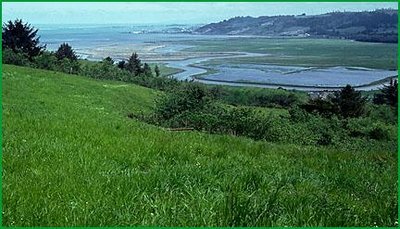Humboldt Bay Flats and Terraces (Bailey)
This subsection is on a coastal plain and terraces between mountains of the northern California Coast Ranges and the Pacific Ocean. The mouths of the Mad, Van Duzen, and Eel Rivers, which drain much of the northern California Coast Ranges, are on this coastal plain. The subsection climate is temperate and humid. There is substantial oceanic influence on climate, including summer fog. MLRA 4b.
Contents
Lithology and Stratigraphy
This subsection is predominantly Quaternary nonmarine and marine terrace deposits and recent alluvium. Also, there are some Plio-Pleistocene nonmarine sediments and, along the ocean shoreline, substantial areas of beach and dune deposits.
Geomorphology
This subsection is on a low coastal plain and marine terraces adjacent to the ocean. Beaches line the outer edge of the plain and dunes of sand spread inland from the beaches. There is a large bay behind this shoreline that has a permanent outlet to the ocean (Pacific Ocean). The Quaternary terraces are only slightly dissected, but the Plio-Pleistocene sediments are highly dissected. They reach elevations up to about 1000 feet. Ocean currents, waves, and wind are active to forming the beaches and dunes. Fluvial erosion and deposition are the main geomorphic processes on the plain and terraces behind the beaches.
Soils
The soils on terraces are mostly Typic Humitropepts and Typic Tropohumults. Tropofluvents, Fluvaquents, and Humaquepts are common soils on recent alluvium. Tropopsamments occur on the dunes. The soil temperature regimes are isomesic and mesic. Soil moisture regimes are mostly udic, and some aquic.
Vegetation
The predominant natural plant communities on the plain and on marine terraces around Trinidad Head and Patricks Point are Sitka spruce series on the outer edge and Redwood series inland. Much of the area has successional cover of shrubs or Red alder series. The dunes support a succession of plant communities, from bare dune through Native dunegrass series, Sand - verbena - beach bursage series, and Beach pine series or Bishop pine series to Sitka spruce series. Pickleweed series is present, but not extensive, in this subsection.
Characteristic series by lifeform include:
- Dune vegetation: Native dunegrass series, European beachgrass series, Sand - verbena - beach bursage series.
- Saltmarsh vegetation: Cordgrass series, Ditch-grass series, Pickleweed series, Saltgrass series.
- Grasslands: Introduced perennial grassland series, Pacific reedgrass series.
- Shrublands: Coyote brush series, Salal - California huckleberry series.
- Forests and woodlands: Beach pine series, Bishop pine series, Red alder series, Sitka spruce series.
Climate
The mean annual precipitation is about 30 to 50 inches. There is summer fog. Mean annual temperature is about 50° to 53° F, and there is less than 12°F difference between lowest and highest monthly means. The mean freeze-free period is about 300 days.
Surface Water
Water runs off of the terraces rapidly, but there are large areas of floodplain along the Eel, Van Duzen, and Mad Rivers. Tidal water enters Humboldt Bay and the mouths of the Mad and Eel Rivers. Brackish water lagoons are common along the coast.
Return to Northern California Coast


